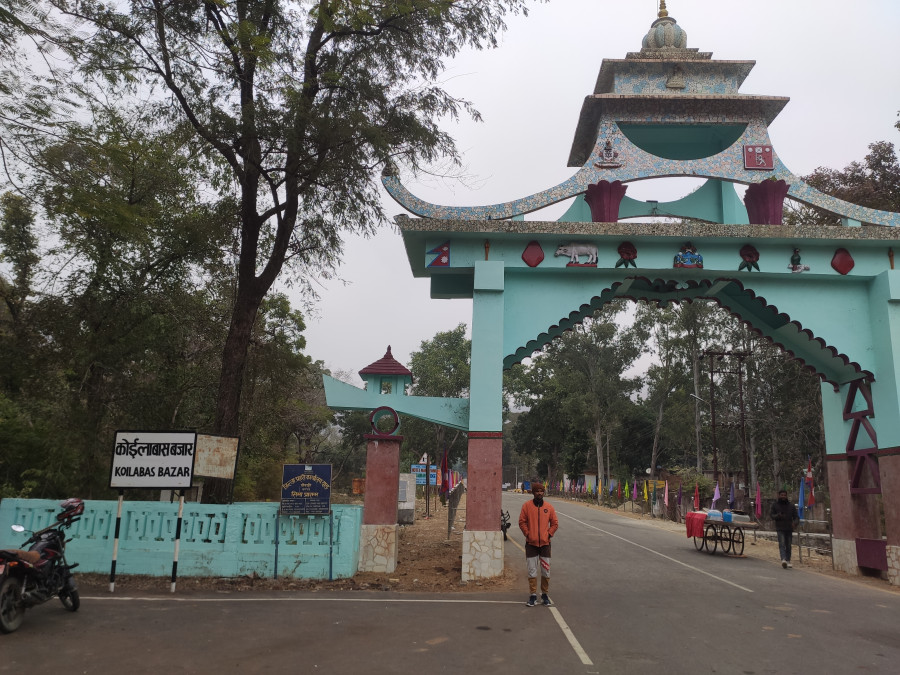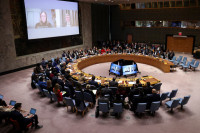Columns
Footnote across the foothills
The deserted town of Koilabas shows how Kathmandu always bypasses those on the margins.
Anurag Acharya
Thousands of traders and ordinary folks flock to Koilabas, a small border town south of Dang Valley in western Nepal. Some of them have travelled from the remote north for many days, with the caravan of bhariyas and khachhars carrying large sacks of Himalayan herbs and hemp. The pungent smells of hing and timmur mingle in the air, mixed with sweat and dust. The big traders from the valley across the north and those from the south seem busy bargaining prices of grains and mustard, while those who have made a long, treacherous journey from the hills heat the ghiu they have carried down to sell in the market. This is a picture of everyday Koilabas in the 1960s.
Located across the dry and sparsely populated Chure range that surrounds Dang Valley, Koilabas was not just a trade hub for the people of the Rapti basin but also a gateway to the world that stretched infinitely across the mighty Indo-Gangetic plains. When the Panchayat government began constructing the Butwal-Kohalpur section of the East-West highway in 1972, it changed the fortunes of people in this part of the country. By 1976, people from the Rapti region could take the highway to access the bigger border markets of Rupaidiha across Nepalgunj in Banke, Barhani Bazaar across Krishna Nagar in Kapilvastu or Gorakhpur across the Sunauli border in Rupandehi district. Within a decade or so, Koilabas was reduced to a footnote in history.
It is not that the people of Koilabas did not see it coming or were unaware of the consequences. But those who were the most affected were the ones who had no voice. The big traders from Kathmandu and elsewhere, who had profited from Koilabas, simply packed up and left for greener pasture, leaving behind deserted mills and warehouses that are now crumbling.
Most residents of this once-thriving border town have already left, as they see no prospects for business or basic public services. A few families that remain may also leave if they can. There are no hospitals in Koilabas, and children graduating from a local primary school or the madrasa school have no access to further education. “There is no Class 6 in my school. All my friends are either going to Balrampur (India) or to Dang next year. I may do the same,” an eight-year-old girl playing inside the 139-year-old Shri Ram Janaki Mandi temple told me.
Despite sending leaders like Parshu Narayan Chaudhary (former chairman of the Royal Advisory Council) and Khum Bahadur Khadka (NC leader and former home minister) to power, for the people of Koilabas, the 33 kilometres of black-topped road that links Koilabas to the national highway has come at least four decades late.
‘Ram bharose’ Koilabas
I approached a group of policemen and the customs officer, who were huddled inside a tea shop opposite the old customs building that the Maoists bombed during the conflict. The office has now been shifted next to the APF barracks a few metres away. “Do you see the number of vehicles crossing the border? We have collected more taxes in the last few days than we have in months,” an officer without a uniform told us. Sabai Ram ko kripa ho (All thanks to Lord Ram), shouted a man from inside the tea shop.
It was getting dark, and there were small groups of people, mostly women, carrying bags full of groceries and vegetables, hurrying back into Nepal from across the border. I took a few pictures at the border crossing despite the clear displeasure of the Indian BSF officials who were gesturing at border officials on our side. As I turned back, a bearded man approached me, introducing himself as the local Nepali Congress leader. Out of curiosity, I asked him about the land prices in Koilabas. The man, who was in his late sixties, laughed at me and promised to tell me when there is a transaction.
Ayodhya, the Indian city of mythological importance, around a two-hour drive from Koilabas, celebrated the consecration of the new Ram temple last month. Built over the rubble of Babri Masjid, demolished by a mob of Hindu Kar Sevaks in 1992, the Ram temple continues to stir emotions among India’s Muslim community. However, just over around 130 kilometres north on this side, Abdul Siddiqi seemed optimistic about the fact that the Ram temple may give a new lease of life to his dying town.
The people of Koilabas may be living on Ram bharose, but the government on this side must also do what it should to ensure that the people living in this deserted town can find their way back into the mainstream of development. The postal highway from Lamahi to Koilabas traverses pristine Chure hills overlooking the great Indo-Gangetic plains. A well-planned tourism infrastructure, packaged and marketed strategically, could attract plenty of Indian tourists, bringing much-needed business and jobs to Koilabas. Thousands of Nepalis will travel to Ayodhya over the next months and years, and they could be encouraged to take the Koilabas route. This, however, will require the provincial government to convince the federal government in Kathmandu to reach out to the Indian side to mutually agree on upgrading the border and transport infrastructure on both sides.
Five decades back, Kathmandu-centered development bypassed this forsaken town. If the provincial capital located 50 kilometres away in Deukhuri is able to right this historic wrong, it will strengthen public faith in Nepal’s federalism.




 16.57°C Kathmandu
16.57°C Kathmandu















